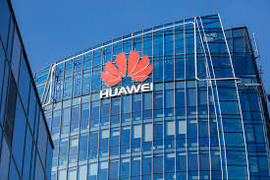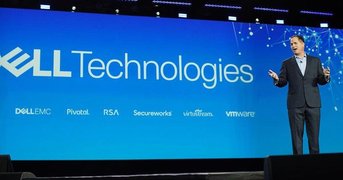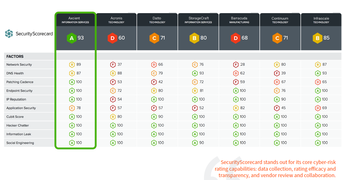Longview IoT Boosts Energy and Wireless Efficiency
Some of the biggest challenges slowing down the adoption of IoT are security, efficient battery usage and optimized wireless communications.One company has...
Full Story »Hallmark's Simple, Inexpensive Way to Boost Customer Satisfaction
In an effort to boost margins, companies often push more users to automated solutions such as FAQs, chatbots, voice bots and anything...
Full Story »Huawei Places the World's First 5G VoNR Video Call
Huawei recently completed the world's first voice over NR (VoNR) call. The voice and video call service was made using two Huawei...
Full Story »IGEL Advances Future of Work
IGEL is a provider of a next-gen edge OS for cloud workspaces. The company’s software products include IGEL OS, IGEL UD Pocket (UDP) and Universal...
Full Story »Tata Communications and Cisco Collaborate on SD-WAN
Tata Communications and Cisco have extended their partnership to enable enterprises to transform their legacy network to a customized and secure multi-cloud...
Full Story »How to Win the 50-Year-Old China Trade War
Today and this week in-fact is historic - the left and right in the U.S. agree that we have a major trade...
Full Story »Extreme Elements Enables The Autonomous Enterprise
Extreme Networks just announced Extreme Elements which in-turn enables the autonomous network and subsequently the autonomous enterprise. In a dynamic webinar, Dan...
Full Story »Cure Charge Anxiety with the Versatile ChargeHubGO+
One of the biggest challenges many of us face is charge anxiety and this problem has gotten worse thanks to USB-C. Personally,...
Full Story »How To Secure the 2020 Election
Securing any election generally can be broken down into a few areas. Disinformation, hacking campaign officials and vote tampering.Here is how to...
Full Story »Future of Work News: Dell, Microsoft, Walmart and Stripe
Its been a big week for the Future of Work. Perhaps the biggest news came from Stripe – they decided their fifth...
Full Story »Was Cleveland Airport Ransomware Attack Preventable?
Cleveland Hopkins International Airport is battling a ransomware attack that knocked out some displays and disabled email and other systems according to reports....
Full Story »What We Learn from Updated Google Workplace Policies
Google has come under tremendous fire in the past for numerous reasons such as its ideological echo chamber which involved firing James...
Full Story »Tech Tips to Help Get Through Stress Awareness Month
Whoops - we just noticed we placed an exclamation point in our headline - that could be stressful, sorry. :-)Please allow us...
Full Story »U.S. Will Go To War In Response to Cyber-Attack
We've mentioned the U.S. is falling behind its allies who are taking a more hawkish stance on cybersecurity and warning hostile actors. In...
Full Story »Pax8 Helps MSPs Maximize Service Revenue and Profit
Ryan Walsh CCO of Pax8 got great reviews from his standing-room session at MSP Expo in Fort Lauderdale this past February when...
Full Story »Axcient Focuses on Better Business Continuity and Cybersecurity for MSPs
“Data protection, file sync and share software developer eFolder and disaster recovery-as-a-service developer Axcient merged in July 2017 under the Axcient name...
Full Story »RingCentral, PCM Partner to Expand Cloud Communications Adoption
Cloud communications in the enterprise have brought innovation and helped to lower costs across the board. These technologies are also connecting businesses...
Full Story »Viasat's Impressive Broadband Solution
“Viasat was founded in the CEO’s garage in eighties and the three founders are still with us. One, Mark Dankberg, is CEO,” said...
Full Story »More Canadian Contact Centers Closing, Downscaling
TMC's Brendan Read has an article today about how four more call centers in Ontario, Canada are either shutting down or are laying off staff. Although this is a bummer for that region -- which has been a hotbed for call centers for many years now -- it's not all that surprising, as companies have been cutting back their contact center operations in Canada for more than a year now, and the Canadian government hasn't been able to do much about it. The trend really began in late 2007, when the U.S. dollar began to weaken, and the exchange rate began to shift in favor of keeping centers here in the U.S., or alternatively sending them overseas. Since then, the world economy has basically tanked -- and consumers and businesses alike simply aren't purchasing in the volumes they did in the past. What's more, the Internet and automated self-serve systems are increasingly meeting consumers' transactional and informational needs, thus there is diminished demand/need for live agent interactions.
Call Centers are 'White Collar Sweatshops?'
CRM Buyer's Maria Verlengia has an article today about how call centers can't hold onto their agents because they are such miserable places to work, plus the pay is so low, plus they offer few opportunities for advancement. In fact, the article refers to call centers as "white collar sweat shops," which in my opinion is true in many ways. As some of you may already know from my past posts, I was a part-time outbound agent, doing mostly market research, during the mid to late 1980s. But it was a totally different time - as the CRM Buyer report points out, today's call centers employ advanced technologies such as call recording/quality monitoring, performance management and workforce management - automated systems which can make agents feel like they are working under the shadow of "Big Brother." Every aspect of the agent's performance today can be measured - the manager can even find out, with surprising accuracy, how many minutes per shift you spend on the john. For that reason I'm not sure I'd make it in today's call center world (and no, it's not due to incontinence ...) The real irony (and a theme which keeps recycling over and over) is how organizations emphasize the importance of the job - after all, a call center agent is on the frontline of your customer service - the person who directly interacts with your customers -- and yet companies generally only pay their agents minimum wage, or something slightly north of that. My analogy is it's like putting an air traffic controller in a tower, telling him he's in charge of protecting the lives of thousands (if not tens of thousands, hundreds of thousands, millions) of people and then offering him $10 an hour.
'Making Contact' Returns!
I'm back! After a year-long stint serving as managing editor for Multichannel Merchant magazine, a Penton Media publication, I'm happy to announce my triumphant return to TMC and the re-launching of the "Making Contact" blog, which is dedicated to all aspects of the call center industry, including technology and training. While I was at Multichannel Merchant, I had the chance to continue covering the call center industry -- at least from a "merchant perspective." The main thing I took away from that experience is that a merhcant's call center is not the same as a bank's call center is not the same as an insurance company's call center is not the same as a utility's call center. Although you can argue that they have more similarities than differences (obviously customer service is paramount, reagrdless of industry or vertical), the differences can be pretty substantial, particularly in terms of the technology they use and the training of the agents. For example, I was really surprised how many merchants could care less what kind of network technology is used in the call center -- TDM is fine for most of them (they love the reliability and signal quality), thank you very much, and they're not all that into automation either. In fact, I sort of came away with the feeling that automation is NOT what most merhcants want -- what they really want are well-trained agents that hang around for a few years, build their skills and learn the brand inside and out -- perhaps even become part of the (gulp) "company culture" -- and not things like IVR systems that push customers away from live agents, or call recording/quality monitoring/workforce management/performance management systems that make agents feel like they're working under the shadow of "Big Brother." "When it comes to selling consumer products, you better have live, knowledgeable people working the phones," seems to be the mantra of direct sellers, retailers and e-tailers everywhere. Whereas banks, utilities and insurance companies seem to be obsessed with finding the right mix of "silver bullet" applications that will enable their customers to "self-serve" and leave their agents alone -- while at the same time remaining satisfied and loyal. Another thing that sort of surprised me is the pervasive the use of order entry systems, also known as order management systems, in merchant call centers. Most of the merchants I interviewed had these systems -- in fact, they are often the main application the agents use for processing orders -- and yet I had never even touched on the topic of order management systems when I was previously covering call center at TMC. A lot of the merchants I interviewed said training agents on these (legacy and sometimes mouse-less) OMSs was typically one of the more time-consuming tasks in the overall training process.
Microsoft Enters the Contact Center Solutions Market With New Tie-Up with Aspect
I know I’m late to the party on this but the recent news about Microsoft’s strategic partnership with Aspect Software to bring unified communications to the contact center is definitely one of the most significant business deals in the contact center space for 2008. You might say this deal represents Microsoft’s grand entry into the contact center space – or at least a very large step in that direction -- however, I wouldn’t lose sight of the fact that many of the other major contact center software makers have already rolled out UC offerings -- and have had customers using them for months. As per the five year strategic alliance, the financial terms of which have not been disclosed, Aspect will design its Aspect Unified IP contact center solution to interoperate with Microsoft’s OCS platform for software-powered voice and unified communications, and will offer it as the leading option to new and existing customers (of course, existing customers can easily upgrade to the UC system). In addition, Microsoft is making an equity investment in Aspect to "accelerate the development and adoption of the new solutions and services." Aspect is one of the largest and best-known providers of contact center solutions for the enterprise: Its solutions are deployed in call and contact centers all around the world. This deal is huge because it gives Microsoft a very large footprint in the contact center space almost instantly. Not to mention the opportunity to significantly accelerate adoption of OCS 2007, which, as you probably already know, can be used to roll out UC across the entire enterprise, and is fully interoperable with most other MS products, making it a very attractive value prop.
Aspect Rolls Out UC Strategy
Aspect Software yesterday announced its new strategy to bring unified communications capabilities to its contact center solutions. Specifically, the company announced that it will soon be introducing enhanced versions of Aspect Unified IP and PerformanceEdge which are fully interoperable with existing unified communications solutions. This, of course, could have been expected – I mean, after all Aspect is one of the largest providers of contact center solutions, and the adoption of unified communications is starting to pick up steam. Considering that so many enterprises already use their contact center telephony systems for communications across most, if not all of the organization (linking together different divisions, departments, remote offices, etc., that are geographically dispersed), it makes perfect sense for contact center platform makers such as Aspect to endow their products with UC capabilities (and many have already done so – for example, TouchStar just recently introduced its new “Unify” product, a browser-based product that facilitates true seamless UC across the enterprise). With these advanced, all-IP solutions and their amazing call routing capabilities, an enterprise can make its contact center system the “communications center” for the entire organization. The advantage of bringing UC to the contact center is that it ushers in the next iteration of the “informal contact center,” where the walls, or barriers if you will, that separate the contact center from the rest of the organization are dissolved, and other “knowledge workers” within the organization can be used as resources for handling customer complaints and a wide range of other issues. To deliver superior customer service, agents need the ability to quickly and effortlessly “escalate” calls and put the customer in contact with someone else in the organization who has the exact skills or expertise to help that customer quickly.
Canada Officials Will Need to Plan Carefully to Weather the Coming Storm
Government officials in the various provinces of Canada which are highly reliant on the call center industry to keep the economy afloat are no doubt scrambling to try to come up with additional incentives and new strategies to keep U.S. companies from pulling their centers out. A recent report from Datamonitor shows that many U.S. firms are now starting to pack up and relocate their Canada-based call center operations due to the increasing value of the U.S. dollar and the increasingly unfavorable exchange rate. Even call center outsourcing behemoth Convergys recently announced that it will be closing some of its facilities in Canada in the coming months.
Skills Shortage in the U.S. Keeps Widening
I’m hearing, with increasing frequency, that there is a serious “skills shortage” in the U.S. labor pool -- especially when it comes to people who possess good IT skills combined with other skill sets. Depending on what sources you refer to, one gets the idea that company IT departments in the U.S. are too slimmed down -- and furthermore that there’s not enough “real talent” to go around. Thus companies are increasingly turning to managed services (including software solutions delivered via the Software-as-a-Service model) and support automation systems to handle some (or most) of their IT needs. In other words, they’re farming out more of their IT needs to third parties for lack of being able to find, attract and retain decent in-house talent. This “skills shortage” is also why recruiting has become so tough in the call center industry: You need people who not only possess good interaction skills, or “people skills,” but who are also relatively tech savvy.
Does God Need a Performance Management Solution Too?
I was at the Call Center Demo show down in Miami this past week – you know, the call center trade show brought to you by the people who no longer have a print publication focused on the call center industry (heh, heh)? Anyway, during the show I noticed that a majority of the exhibitors were focused on the workforce optimization space – which by definition includes workforce management, performance management, call recording, quality monitoring. e-learning and analytics. Apparently Tracey Schelmetic, editor of Customer Interaction Solutions, TMC’s illustrious print publication focused on the call center industry, got it right when she dubbed 2008 “The Year of Workforce Optimization” on the front cover of this month’s issue. From the look of this past week’s Call Center Demo show, I’d say she hit the nail on the head. Breaking down the exhibitor list, there were nine companies offering workforce management; ten companies offering performance management; ten companies offering call recording; nine companies offering QM or “quality assurance;” and 11 companies offering analytics (Web and Speech). Of course, there is duplication in each category, as many of these companies offer a suite of products for addressing some or all of the technology “disciplines” that make up the WFO realm.
Datamonitor: Convergys the First, But Unlikely the Last, to Pull its Call Centers Out of Canada
A new report from market research firm Datamonitor shows what many of us already know: Companies are starting to pack up and relocate their Canada-based call center operations due to the increasing value of the U.S. dollar and the increasingly unfavorable exchange rate. Even call center outsourcing behemoth Convergys has announced that it will be closing some of its facilities in Canada in the coming months – this news coming directly from the mouth of Convergys CEO David Dougherty. “Convergys’ announcement of a scale-back on Canadian operations could be the first of many by outsourcers,” warned Peter Ryan, head of contact center outsourcing analysis at Datamonitor, in a press release. He said the decline of the U.S. dollar “has badly eroded the profitability of U.S.
Maximizer Rounds Out Maximizer CRM 10 Suite with New Entrepreneur Edition
Maximizer Software Inc. has released the Entrepreneur Edition of Maximizer CRM 10 – thus rounding out its CRM software suite with a new edition targeted at the small business. Maximizer CRM 10 already included covered the SMB market well with its Group, Professional and Enterprise Editions. Now, with the introduction of the Entrepreneur Edition, the suite has an edition for every size business (including departments within a larger organization), from small to medium to large to enterprise. In fact, Maximizer claims it is now “the only vendor that offers a complete family of CRM products for small and medium-sized businesses (SMBs) that enables a smooth migration from contact management through to full-featured CRM.” Its CRM software suite is now flexible and scalable enough that it can help a business of one grow to become a business of “500 or beyond.” Introduced this past November, Maximizer CRM 10 represents a departure from Maximizer’s previous CRM product line, in that it has eliminated the former stand-alone Enterprise edition found in version 9 and combined it into a more full-spectrum version with different editions to suit the needs of different-sized companies. The new Entrepreneur Edition covers the “small” end of the spectrum, but as company officials point out, this easy-to-use, turn-key CRM solution offers advanced functionality found on more expensive systems – including, perhaps best of all, CRM for BlackBerry smartphones. Even a small business can benefit from a mobile CRM solution. With mobile CRM, your workers can have access to the critical business information they need via their BlackBerry devices, and the ability to manipulate it in near real time. Maximizer claims that one big advantage of its software suite is that it lets companies transition to mobile CRM at their own pace (or as the business grows), from basic mobile messaging to full-fledged mobile CRM (with full access to real data, and the ability manipulate it in real time, as well as the ability to conduct transactions remotely).













-thumb-autox180-17023.jpg)









